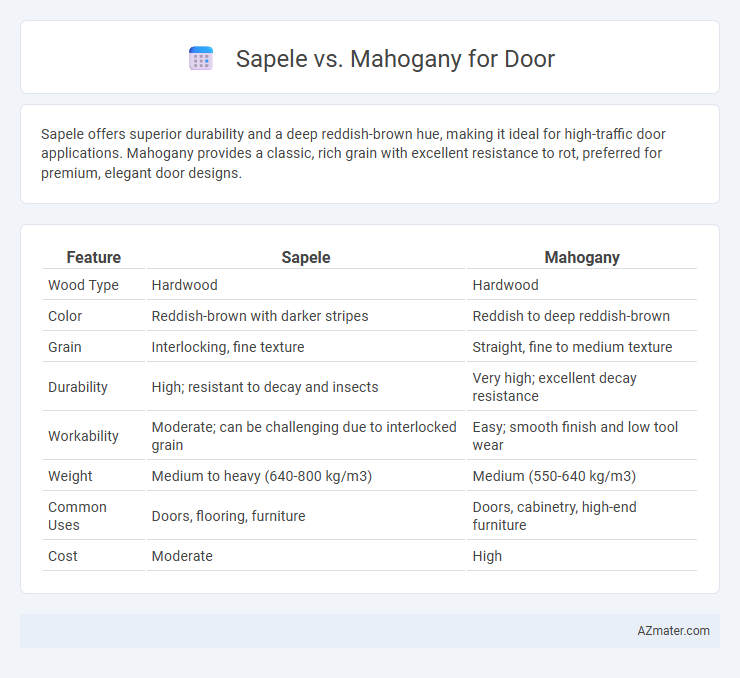Sapele offers superior durability and a deep reddish-brown hue, making it ideal for high-traffic door applications. Mahogany provides a classic, rich grain with excellent resistance to rot, preferred for premium, elegant door designs.
Table of Comparison
| Feature | Sapele | Mahogany |
|---|---|---|
| Wood Type | Hardwood | Hardwood |
| Color | Reddish-brown with darker stripes | Reddish to deep reddish-brown |
| Grain | Interlocking, fine texture | Straight, fine to medium texture |
| Durability | High; resistant to decay and insects | Very high; excellent decay resistance |
| Workability | Moderate; can be challenging due to interlocked grain | Easy; smooth finish and low tool wear |
| Weight | Medium to heavy (640-800 kg/m3) | Medium (550-640 kg/m3) |
| Common Uses | Doors, flooring, furniture | Doors, cabinetry, high-end furniture |
| Cost | Moderate | High |
Introduction: Understanding Sapele and Mahogany
Sapele and Mahogany are two popular hardwoods commonly used in door manufacturing due to their durability and aesthetic appeal. Sapele, known for its reddish-brown hue and interlocking grain pattern, offers excellent resistance to warping and insect damage, making it ideal for exterior doors. Mahogany features a rich, deep reddish-brown color with a straight and fine grain, prized for its stability and luxurious finish in high-end interior and exterior door applications.
Wood Origin and Botanical Characteristics
Sapele, originating from West Africa, belongs to the Meliaceae family and is botanically classified as Entandrophragma cylindricum, known for its interlocking grain and high durability, making it ideal for doors. Mahogany, traditionally harvested from the Swietenia genus in Central and South America, features a straight to slightly interlocked grain and rich reddish-brown color, prized for its stability and workability in fine woodworking. Both woods offer strong resistance to decay and insect attacks, but Sapele's denser texture provides slightly higher hardness compared to most mahogany species.
Appearance: Color and Grain Differences
Sapele wood exhibits a rich reddish-brown color that darkens over time, featuring a distinctive interlocking grain pattern with a subtle shimmer, making it ideal for elegant, warm-toned doors. Mahogany offers a deeper, reddish-brown hue with a more consistent, straight grain that provides a smooth, classic appearance, prized for its timeless and luxurious aesthetic. The color variation and grain complexity in Sapele create a dynamic visual texture, while Mahogany's uniformity gives doors a refined and polished look.
Durability and Strength Comparison
Sapele wood offers excellent durability with a Janka hardness rating of around 1,410, making it highly resistant to dents and wear, while Mahogany varies by species, typically ranging from 800 to 1,070. Sapele's interlocked grain structure provides greater stability and strength, ideal for high-traffic door areas, compared to Mahogany's softer, less dense composition. Both woods resist decay and insects well, but Sapele's superior hardness ensures better longevity and structural integrity in door applications.
Workability: Ease of Machining and Finishing
Sapele offers excellent workability with its fine grain and moderate density, enabling smooth machining and a polished finish without excessive effort. Mahogany, known for its straight grain and medium hardness, allows easy cutting, shaping, and sanding, resulting in a consistently smooth surface ideal for staining or varnishing. Both woods respond well to hand and machine tools, but Sapele's slightly interlocked grain may require sharper blades for optimal finishing.
Resistance to Weather and Insects
Sapele wood demonstrates superior resistance to both weather and insect damage compared to mahogany, making it an ideal choice for exterior doors exposed to harsh environmental conditions. Its natural oils and dense grain structure provide enhanced durability against moisture, decay, and termite attacks, ensuring long-lasting performance. While mahogany offers aesthetic appeal and moderate resistance, Sapele's toughness and resilience make it more reliable for weather-exposed door applications.
Acoustic and Insulation Properties
Sapele wood offers excellent acoustic properties due to its dense grain, making it preferable for doors that require sound insulation and noise reduction. Mahogany, while also dense, provides superior thermal insulation and moderate sound dampening, ideal for maintaining indoor temperatures and reducing external noise. Both woods balance durability and aesthetics, but Sapele excels in acoustic performance and Mahogany in overall insulation efficiency.
Cost and Availability in the Market
Sapele wood typically costs less than genuine Mahogany, making it a more budget-friendly option for door manufacturing. Sapele's availability is higher due to sustainable harvesting practices and widespread plantations, whereas true Mahogany faces supply constraints from deforestation regulations and slower growth rates. These factors make Sapele a more accessible and economical choice for homeowners and builders seeking quality wood doors.
Sustainability and Environmental Impact
Sapele wood, harvested primarily from West African forests, is often considered more sustainable than traditional mahogany due to faster growth rates and better forest management practices. Mahogany, especially species like Swietenia macrophylla, faces significant overharvesting and illegal logging concerns, leading to its listing under CITES Appendix II to regulate trade. Choosing Sapele for door construction supports responsible sourcing and reduces deforestation impact compared to mahogany, which has a higher ecological footprint.
Choosing the Right Wood for Your Door
Sapele offers a rich, reddish-brown hue with a fine grain, making it a durable and cost-effective choice for doors, while mahogany is prized for its deep, warm color and exceptional resistance to decay, ideal for high-end, long-lasting doors. Both woods provide excellent stability and workability, but mahogany's natural oils enhance its resistance to moisture, reducing maintenance in humid environments. Consider your budget, aesthetic preference, and climate conditions when choosing between Sapele and mahogany to ensure a door that balances beauty, durability, and functionality.

Infographic: Sapele vs Mahogany for Door
 azmater.com
azmater.com